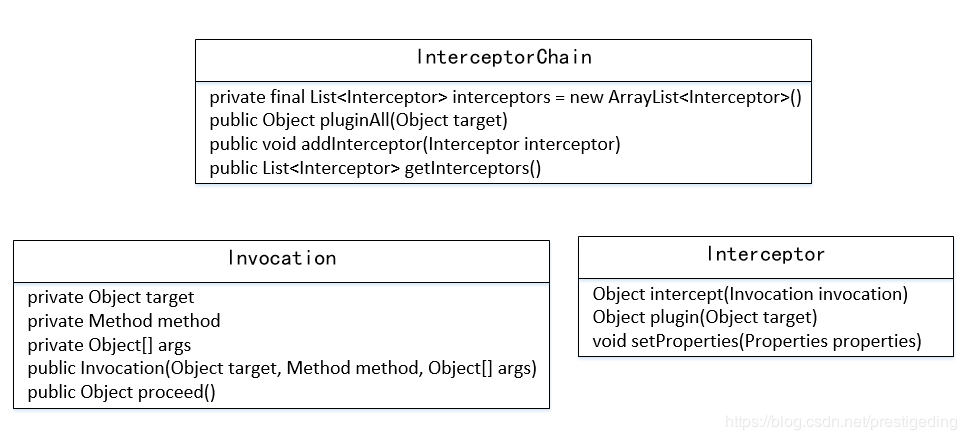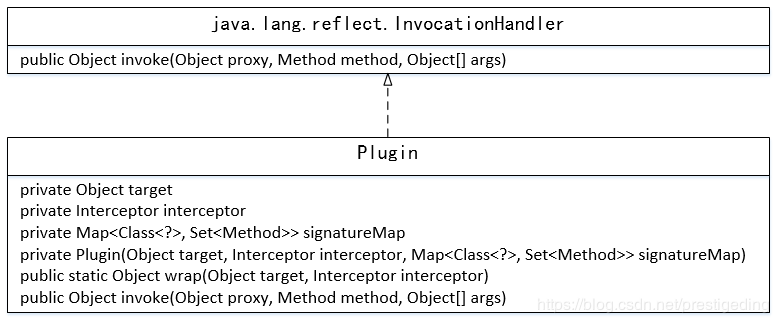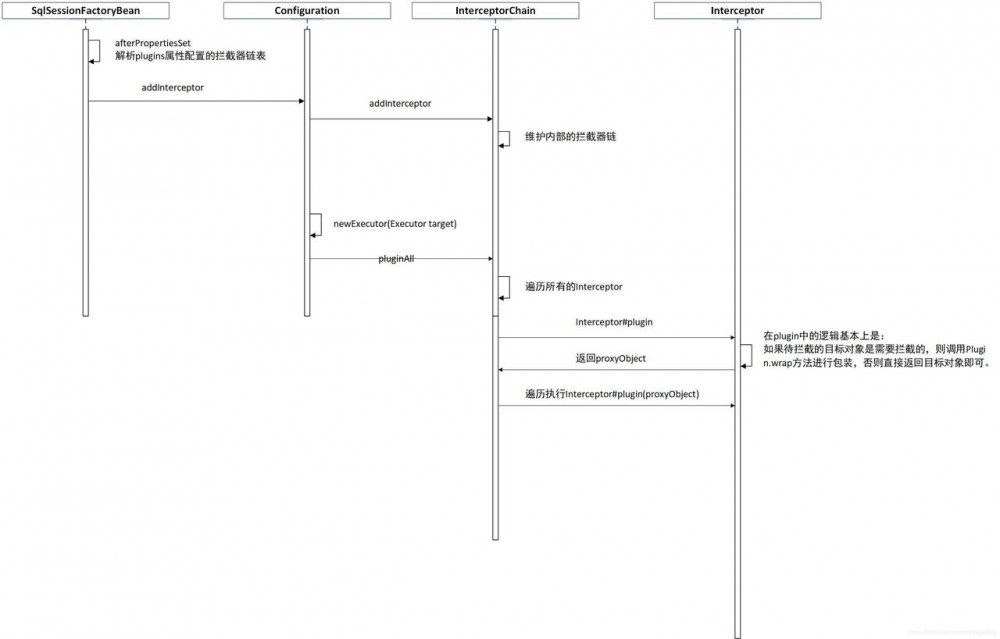源码分析Mybatis插件(Plugin)机制与实战(图文并茂、提问式源码阅读技巧)
有了 《Mybatis执行SQL的4大基础组件详解》 与 《源码解析MyBatis Sharding-Jdbc SQL语句执行流程详解》 两篇文章的铺垫,本文将直奔主题:Mybatis插件机制。
温馨提示:本文也是以提问式阅读与探究源码的技巧展示。
1、回顾
从前面的文章我们已经知道,Mybatis在执行SQL语句的扩展点为Executor、StatementHandler、ParameterHandler与ResultSetHandler,我们本节将以Executor为入口,向大家展示Mybatis插件的扩展机制。
我们先来看回顾一下Mybatis Executor的创建入口。
1.1 Configuration#newExecutor
public Executor newExecutor(Transaction transaction, ExecutorType executorType) {
executorType = executorType == null ? defaultExecutorType : executorType;
executorType = executorType == null ? ExecutorType.SIMPLE : executorType;
Executor executor;
if (ExecutorType.BATCH == executorType) {
executor = new BatchExecutor(this, transaction);
} else if (ExecutorType.REUSE == executorType) {
executor = new ReuseExecutor(this, transaction);
} else {
executor = new SimpleExecutor(this, transaction);
}
if (cacheEnabled) {
executor = new CachingExecutor(executor);
}
executor = (Executor) interceptorChain.pluginAll(executor); // @1
return executor;
}
复制代码
代码@1,:使用InterceptorChain.pluginAll(executor)进行拆件化处理。
思考:使用该方法调用后,会返回一个什么对象呢?如何自定义拆件,自定义插件如何执行呢?
那接下来我们带着上述疑问,从InterceptorChain类开始进行深入学习。
2、InterceptorChain
从名字上看其大意为拦截器链。
2.1 类图

- InterceptorChain 拦截器链,其内部维护一个interceptors,表示拦截器链中所有的拦截器,并提供增加或获取拦截器链的方法,下面会重点分析pluginAll方法。
- Interceptor 拦截器接口,用户自定义的拦截器需要实现该接口。
- Invocation 拦截器执行时的上下文环境,其实就是目标方法的调用信息,包含目标对象、调用的方法信息、参数信息。其中包含一个非常重要的方法:proceed。
public Object proceed() throws InvocationTargetException, IllegalAccessException {
return method.invoke(target, args);
}
复制代码
该方法的主要目的就是进行处理链的传播,执行完拦截器的方法后,最终需要调用目标方法的invoke方法。
记下来中先重点分析一下InterceptorChain方法的pluginAll方法,因为从开头也知道,Mybatis在创建对象时,是调用该方法,完成目标对象的包装。
2.2 核心方法一览
2.2.1 pluginAll
public Object pluginAll(Object target) { // @1
for (Interceptor interceptor : interceptors) { // @2
target = interceptor.plugin(target);
// @3
}
return target;
}
复制代码
代码@1:目标对象,需要被代理的对象。
代码@2:遍历InterceptorChain的拦截器链,分别调用Intercpetor对象的Plugin进行拦截(@3)。
那接下来有三个疑问? 问题1:InterceptorChain中的interceptors是从什么时候初始化的呢,即拦截链中的拦截器从何而来。 问题2:从前面也得知,无论是创建Executor,还是创建StatementHandler等,都是调用InterceptorChain#pluginAll方法,那是不是拦截器中的拦截器都会作用与目标对象,这应该是有问题的,该如何处理? 问题3:代理对象是如何创建的。
2.2.1 addInterceptor
public void addInterceptor(Interceptor interceptor) {
interceptors.add(interceptor);
}
复制代码
要想知道interceptors是如何初始化的,我们只需要查看该方法的调用链即可。
一路跟踪到源头,我们会发现在初始化SqlSessionFactory时,会解析一个标签plugin,就可以得知,会在SqlSessionFacotry的一个属性中配置所有的拦截器。 具体配置示例如下:
<bean id="sqlSessionFactory" class="org.mybatis.spring.SqlSessionFactoryBean">
<property name="dataSource" ref="shardingDataSource"/>
<property name="mapperLocations" value="classpath*:META-INF/mybatis/mappers/OrderMapper.xml"/>
<property name="plugins">
<array>
<bean id = "teneantInteceptor" class="com.demo.inteceptor.TenaInteceptor"></bean>
</array>
</property>
</bean>
复制代码
问题1已经解决。但后面两个问题似乎没有什么突破口。由于目前所涉及的三个类,显然不足以给我们提供答案,我们先将目光移到InterceptorChain所在包中的其他类,看看其他类的职责如何。
3、Intercepts与Signature
在org.apache.ibatis.plugin中存在如下两个注解类:Intercepts与Signature,从字面意思就是用来配置拦截的方法信息。

- Siganature注解的属性说明如下:
- Class<?> type :需要拦截目标对象的类。
- String method:需要拦截目标类的方法名。
- Class<?>[] args:需要拦截目标类的方法名的参数类型签名。
备注:至于如何得知上述字段的含义,请看下文的Plugin#getSignatureMap方法。
但另外一个类型Plugin类确引起了我的注意。接下来我们将重点分析Plugin方法。
4、Plugin详解
4.1 Plugin类图

其中InvocationHandler为JDK的动态代理机制中的事件执行器,我们可以隐约阈值代理对象的生成将基于JDK内置的动态代理机制。
Plugin的核心属性如下:
- Object target 目标对象。
- Interceptor interceptor 拦截器对象。
- Map<Class<?>, Set< Method>> signatureMap 拦截器中的签名映射。
4.2 构造函数
private Plugin(Object target, Interceptor interceptor, Map<Class<?>, Set<Method>> signatureMap) {
this.target = target;
this.interceptor = interceptor;
this.signatureMap = signatureMap;
}
复制代码
注意:其构造函数为私有的,那如何构建Plugin呢,其构造方法为Plugin的镜头方法wrap中被调用。
4.3 核心方法详解
4.3.1 wrap
public static Object wrap(Object target, Interceptor interceptor) {
Map<Class<?>, Set<Method>> signatureMap = getSignatureMap(interceptor); // @1
Class<?> type = target.getClass();
Class<?>[] interfaces = getAllInterfaces(type, signatureMap); // @2
if (interfaces.length > 0) {
return Proxy.newProxyInstance( // @3
type.getClassLoader(),
interfaces,
new Plugin(target, interceptor, signatureMap));
}
return target;
}
复制代码
代码@1:获取待包装的Interceptor的方法签名映射表,稍后详细分析。
代码@2:获取需要代理的对象的Class上声明的所有接口。
代码@3:使用JDK内置的Proxy创建代理对象。Proxy创建代理对象的方法声明如下:
public static Object newProxyInstance(ClassLoader loader,Class<?>[] interfaces,InvocationHandler h), 复制代码
注意其事件处理器为Plugin,故在动态运行过程中会执行Plugin的invoker方法。
在进入Plugin#invoker方法学习之前,我们先重点查看一下getSignatureMap、getAllInterfaces的实现。
4.3.2 getSignatureMap
private static Map<Class<?>, Set<Method>> getSignatureMap(Interceptor interceptor) {
Intercepts interceptsAnnotation = interceptor.getClass().getAnnotation(Intercepts.class); // @1
if (interceptsAnnotation == null) { // issue #251 // @2
throw new PluginException("No @Intercepts annotation was found in interceptor " + interceptor.getClass().getName());
}
Signature[] sigs = interceptsAnnotation.value(); // @3
Map<Class<?>, Set<Method>> signatureMap = new HashMap<Class<?>, Set<Method>>();
for (Signature sig : sigs) {
Set<Method> methods = signatureMap.get(sig.type());
if (methods == null) {
methods = new HashSet<Method>();
signatureMap.put(sig.type(), methods);
}
try {
Method method = sig.type().getMethod(sig.method(), sig.args());
methods.add(method);
} catch (NoSuchMethodException e) {
throw new PluginException("Could not find method on " + sig.type() + " named " + sig.method() + ". Cause: " + e, e);
}
}
return signatureMap;
}
复制代码
代码@1:首先从Interceptor的类上获取Intercepts注解。
代码@2:如果Interceptor的类上没有定义Intercepts注解,则抛出异常,说明我们在自定义插件时,必须要有Intercepts注解。
代码@3:解析Interceptor的values属性(Signature[])数组,然后存入HashMap<Class<?>, Set< Method>>容器内。
温馨提示:从这里可以得知:自定义的插件必须定义Intercepts注解,其注解的value值为Signature。
4.3.3 getAllInterfaces
private static Class<?>[] getAllInterfaces(Class<?> type, Map<Class<?>, Set<Method>> signatureMap) {
Set<Class<?>> interfaces = new HashSet<Class<?>>();
while (type != null) {
for (Class<?> c : type.getInterfaces()) {
if (signatureMap.containsKey(c)) {
interfaces.add(c);
}
}
type = type.getSuperclass();
}
return interfaces.toArray(new Class<?>[interfaces.size()]);
}
复制代码
该方法的实现比较简单,并不是获取目标对象所实现的所有接口,而是返回需要拦截的方法所包括的接口。
4.3.4 invoke
public Object invoke(Object proxy, Method method, Object[] args) throws Throwable { // @1
try {
Set<Method> methods = signatureMap.get(method.getDeclaringClass());
if (methods != null && methods.contains(method)) { // @2
return interceptor.intercept(new Invocation(target, method, args)); // @3
}
return method.invoke(target, args); // @4
} catch (Exception e) {
throw ExceptionUtil.unwrapThrowable(e);
}
}
复制代码
代码@1:首先对其参数列表做一个简单的说明:
- Object proxy 当前的代理对象
- Method method 当前执行的方法
- Object[] args 当前执行方法的参数
代码@2:获取当前执行方法所属的类,并获取需要被拦截的方法集合。
代码@3:如果需被拦截的方法集合包含当前执行的方法,则执行拦截器的interceptor方法。
代码@4:如果不是,则直接调用目标方法的Invoke方法。
从该方法可以看出Interceptor接口的intercept方法就是拦截器自身需要实现的逻辑,其参数为Invocation,在该方法的结束,需要调用invocation#proceed()方法,进行拦截器链的传播。
从目前的学习中,我们已经了解了Plugin.wrap方法就是生成带来带来类的唯一入口,那该方法在什么地方调用呢?从代码类库中没有找到该方法的调用链,说明该方法是供用户调用的。
再看InterceptorChain方法的pluginAll方法:
public Object pluginAll(Object target) { // @1
for (Interceptor interceptor : interceptors) { // @2
target = interceptor.plugin(target); // @3
}
return target;
}
复制代码
该方法会遍历用户定义的插件实现类(Interceptor),并调用Interceptor的plugin方法,对target进行拆件化处理,即我们在实现自定义的Interceptor方法时,在plugin中需要根据自己的逻辑,对目标对象进行包装(代理),创建代理对象,那我们就可以在该方法中使用Plugin#wrap来创建代理类。
接下来我们再来用序列图来对上述源码分析做一个总结:

看到这里,大家是否对上面提出的3个问题都已经有了自己的答案了。
问题1:InterceptorChain中的interceptors是从什么时候初始化的呢,即拦截链中的拦截器从何而来。 答:在初始化SqlSesstionFactory的时候,会解析属性plugins属性,会加载所有的拦截器到InterceptorChain中。
问题2:从前面也得知,无论是创建Executor,还是创建StatementHandler等,都是调用InterceptorChain#pluginAll方法,那是不是拦截器中的拦截器都会作用与目标对象,这应该是有问题的,该如何处理?
答案是在各自订阅的Interceptor#plugin方法中,我们可以根据传入的目标对象,是否是该拦截器关注的,如果不关注,则直接返回目标对象,如果关注,则使用Plugin#wrap方法创建代理对象。
问题3:代理对象是如何创建的? 代理对象是使用JDK的动态代理机制创建,使用Plugin#wrap方法创建。
5、实践
实践是检验真理的唯一标准,那到底如何使用Mybatis的插件机制呢? 创建自定义的拦截器Interceptor,实现Interceptor接口。 1)实现plugin方法,在该方法中决定是否需要创建代理对象,如果创建,使用Plugin#wrap方法创建。 2)实现interceptor方法,该方法中定义拦截器的逻辑,并且在最后请调用invocation.proceed()方法传递拦截器链。 3)使用Intercepts注解,定义需要拦截目标对象的方法签名,支持多个。 将实现的Interceptor在定义SqlSessionFactory的配置中,放入plugins属性。
最后给出一个Mybatis Plugin插件机制使用案例:基于Mycat+Mybatis的多租户方案: 基于Mybatis与Mycat的多租户方式,通过Mybatis的插件机制,动态改写SQL语句来实现多租户
作者介绍:《RocketMQ技术内幕》作者,维护公众号: 中间件兴趣圈 ,目前主要发表了源码阅读java集合、JUC(java并发包)、Netty、ElasticJob、Mycat、Dubbo、RocketMQ、mybaits等系列源码。

- 本文标签: CTO mybatis ACE mapper MQ 构造方法 HashSet classpath cat 代码 插件 http SqlSessionFactory iBATIS session 并发 ssl find Netty value src bean IO HashMap 类图 apache tar NSA key 详细分析 Action executor 提问 Proxy java UI XML dataSource Property cache sharding newProxyInstance spring 突破 配置 遍历 dubbo 处理器 StatementHandler RocketMQ ResultSet https 解析 总结 Job plugin id Statement db map App 参数 文章 sqlsession Java集合 JDBC 源码 sql
- 版权声明: 本文为互联网转载文章,出处已在文章中说明(部分除外)。如果侵权,请联系本站长删除,谢谢。
- 本文海报: 生成海报一 生成海报二











![[HBLOG]公众号](https://www.liuhaihua.cn/img/qrcode_gzh.jpg)

